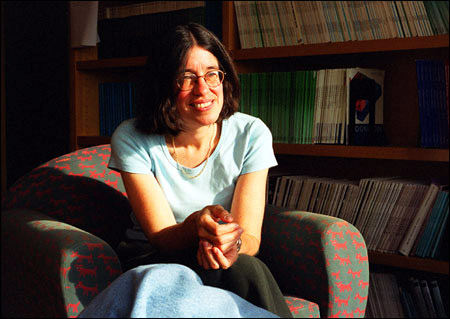Which comes first, language or thought?
Babies think first

It’s like the chicken and egg question. Do we learn to think before we speak, or does language shape our thoughts? New experiments with five-month-olds favor the conclusion that thought comes first.
“Infants are born with a language-independent system for thinking about objects,” says Elizabeth Spelke, a professor of psychology at Harvard. “These concepts give meaning to the words they learn later.”
Speakers of different languages notice different things and so make different distinctions. For example, when Koreans say that one object joins another, they specify whether the objects touch tightly or loosely. English speakers, in contrast, say whether one object is in or on another. Saying “I put the spoon cup” is not correct in either language. The spoon has to be “in” or “on” the cup in English, and has to be held tightly or loosely by the cup in Korean.
These differences affect how adults view the world. When Koreans and Americans see the same everyday events (an apple in a bowl, a cap on a pen), they categorize them in accord with the distinctions of their languages. Because languages differ this way, many scientists suspected that children must learn the relevant concepts as they learn their language. That’s wrong, Spelke insists.
Infants of English-speaking parents easily grasp the Korean distinction between a cylinder fitting loosely or tightly into a container. In other words, children come into the world with the ability to describe what’s on their young minds in English, Korean, or any other language. But differences in niceties of thought not reflected in a language go unspoken when they get older.
Spelke and Susan Hespos, a psychologist at Vanderbilt University in Nashville, Tenn., did some clever experiments to show that the idea of tight/loose fitting comes before the words that are used/not used to describe it.
When babies see something new, they will look at it until they get bored. Hespos and Spelke used this well-known fact to show different groups of five-month-olds a series of cylinders being placed in and on tight- or loose-fitting containers. The babies watched until they were bored and quit looking. After that happened, the researchers showed them other objects that fit tightly or loosely together. The change got and held their attention for a while, contrary to American college students who failed to notice it. This showed that babies raised in English-speaking communities were sensitive to separate categories of meaning used by Korean, but not by English, adult speakers. By the time the children grow up, their sensitivity to this distinction is lost.
Other experiments show that infants use the distinction between tight and loose fits to predict how a container will behave when you move the object inside it. This capacity, then, “seems to be linked to mechanisms for representing objects and their motions,” Hespos and Spelke report.
Their findings suggest that language reduces sensitivity to thought distinctions not considered by the native language. “Because chimps and monkeys show similar expectations about objects, languages are probably built on concepts that evolved before humans did,” Spelke suggests.
The researchers describe their experiments and conclusions in the July 22 issue of the scientific journal Nature.
The sounds of meaning
Their findings parallel experiments done by others, which show that, before babies learn to talk for themselves, they are receptive to the sounds of all languages. But sensitivity to nonnative language sounds drops after the first year of life. “It’s not that children become increasingly sensitive to distinctions made in the language they are exposed to,” comments Paul Bloom of Yale University. Instead, they start off sensitive to every distinction that languages make, then they become insensitive to those that are irrelevant. They learn what to ignore, Bloom notes in an article accompanying the Hespos/Spelke report.
As with words, if a child doesn’t hear sound distinctions that it is capable of knowing, the youngster loses his or her ability to use them. It’s a good example of use it or lose it. This is one reason why it is so difficult for adults to learn a second language, Bloom observes. “Adults’ recognition of nonnative speech sounds may improve with training but rarely attains native facility,” Spelke adds.
Speech is for communicating so once a language is learned nothing is lost by ignoring sounds irrelevant to it. However, contrasts such as loose-versus-tight fit help us make sense of the world. Although mature English speakers don’t spontaneously notice these categories, they have little difficulty distinguishing them when they are pointed out. Therefore, the effect of language experience may be more dramatic at the crossroad of hearing and sound than at the interface of thinking and word meaning, Hespos and Spelke say.
Even if babies come equipped with all concepts that languages require, children may learn optional word meanings differently. Consider “fragile” or “delicately,” which, unlike “in,” you can leave out when you say “she delicately placed the spoon in the fragile cup.”
One view, Bloom points out, “is that there exists a universal core of meaningful distinctions that all humans share, but other distinctions that people make are shaped by the forces of language. On the other hand, language learning might really be the act of learning to express ideas that already exist,” as in the case of the situation studied by Hespos and Spelke.
There are lots of situations involving the relation between ideas and language that Hespos and Spelke did not address, so the debate is still open. Do people think before they speak or do words shape their thoughts?




